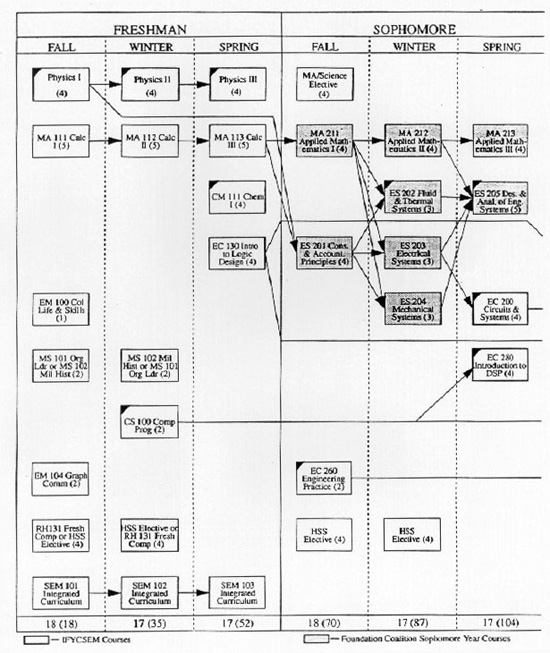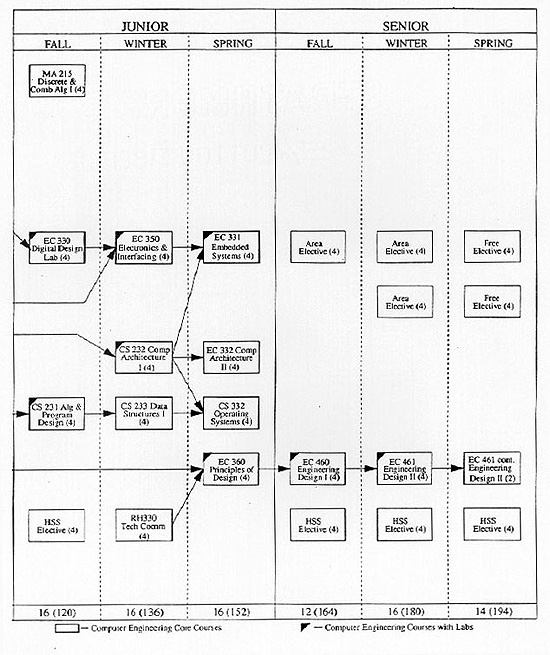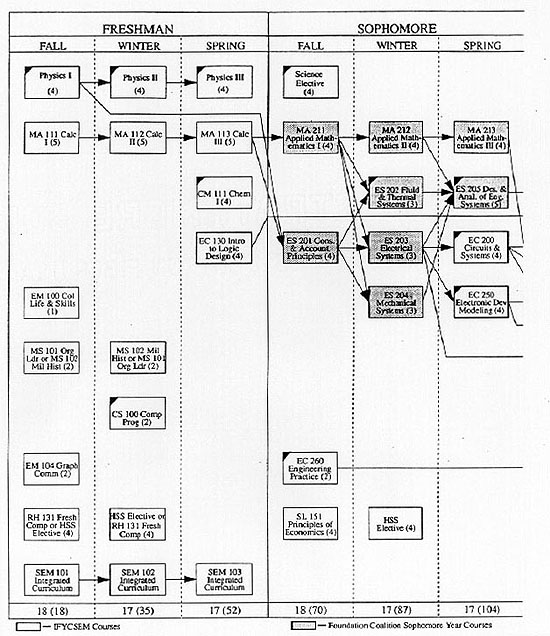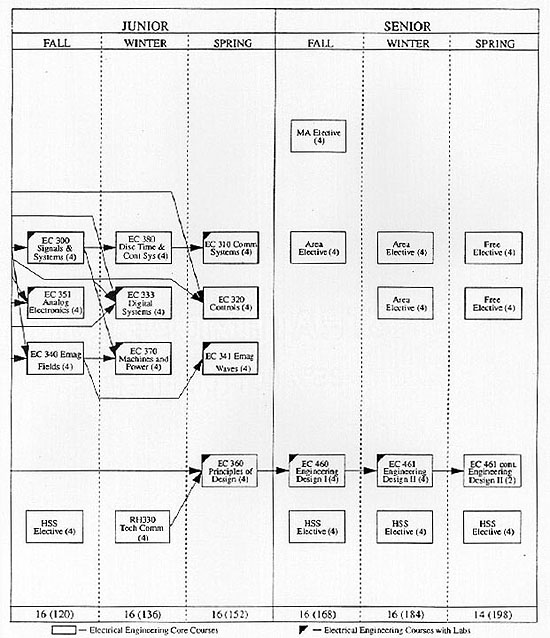
ABSTRACT
Two new degree programs(1) are now being offered by the department of Electrical & Computer Engineering at Rose-Hulman Institute of Technology. The new Bachelor's programs in Electrical Engineering and Computer Engineering, are the result of a top-down curriculum design process which took several years to complete. Many changes took place in the workplace during the 1990's which are guaranteed to continue. In order to produce graduate engineers with the appropriate skills it is necessary to change the process by which they are produced.
The presentation will describe the new programs and their underlying philosophy and report on some of our early impressions of their ability to produce 'Renaissance Engineers' - engineers who will be able to prosper in the workplace of the twenty-first century. The conference presentation will include a program overview and also address issues pertaining to the process of curriculum re-structuring.
INTRODUCTION
The Preliminaries
Change is the Status Quo! Dramatic changes have taken place in the workplace during the 1990's which have affected the way engineering is practiced, and furthermore the rate of change is increasing. The workplace has changed, the tools of the engineering profession have changed, the generation for which we have the responsibility of training has changed, and there are increased economic pressures associated with the global environment in which our corporate colleagues find themselves. These factors combine to produce a paradigm shift in the mode of operation of the engineering workplace and we must respond by providing programs that will enable generation X teenagers(2) to become engineers who are able to prosper in this demanding environment. We were aware of the fact that freshmen entering college in the late 1980's and early 1990's were different from their predecessors. This generation has a different approach to life, different values and most certainly different academic skills and motivation! This topic will have been well-aired in a variety of forums at most institutions and, notwithstanding our desire to have high schools do more, we have to meet students where they are!
In addition to the realization that the real world was changing, the academic community also acknowledged the comparable paradigm shift occurring in criteria upon which the Accreditation Board for Engineering and Technology (ABET) would be basing accreditation decisions - ABET Criteria-2000.
The concept that "change IS the status quo" was embedded in the minds of Rose-Hulman's ECE faculty as the two new programs were developed. The new Electrical Engineering and Computer Engineering programs are the result of four years of curriculum re-engineering by departmental faculty who enthusiastically accepted the challenge. We will not consider the task fully completed until the first cohort of students graduate in May 1998.
Phase 1 of the curriculum restructuring process started in the early 1990's with a departmental discussion which culminated on December 17, 1993 with the adoption of a set of undergraduate engineering goals. These have guided our efforts throughout this on-going process, were adopted before recent ABET developments and will stand the department in good stead as it prepares for Criteria 2000-based accreditation in the future. This author believes that the Criteria 2000 initiative presents a unique opportunity for the academic engineering community to make a quantum leap in improve the quality of engineering education in the United States.
Coupled with these external events were a number of internal factors that also contributed to the impetus for change. It is not appropriate in this paper to do more than list them and they include: the growing dissatisfaction by ECE faculty with a curriculum that had been enhanced over the previous decade by piecemeal addition of topics, a Commission on the Future which had generated in excess of 120 goals for the institution, a desire to embrace technological enhancements by building upon prior experience with computerized classrooms and symbolic algebra systems in teaching mathematics, the appointment of a new department head and his desire to require a year-long senior engineering design experience and the recognition that the educational process can be enhanced by coupling it more tightly with industry.
The Premise
The underlying premise is that we must change the process by which engineers are trained if our graduates are to be competitive in the workplace of the future. If we do not, we should not expect them to be any different from traditional graduates. That is, "If you do what you always did, you'll get what you always got"! Therefore, new engineering programs must:
The Process
The process of design is an important component of our professional skill set as engineers, and our curriculum design process has utilized that expertise. In any well-organized design environment there are professional standards to be upheld, a team mentality which requires that all members understand (and adhere to) guidelines for acceptable behavior, and a sincere desire to "get the job done". Without these, the team has difficulty in functioning and every step along the way is open to conflict, delay and eventually, failure. The first step in the design process is to solidify system specifications which, in the educational environment, is a set of educational goals upon which the faculty agree. Our process also included a discussion of the role of the department in the educational context (relationship with students) and the institutional context, (relationship with our colleagues) as well as its role relating to the professional development of the faculty (their interaction with our industrial partners). The process of developing a set of goals is as important as the product itself, perhaps even more important, as it enables the faculty to understand alternative viewpoints, requires them to rationalize their own and eventually to "buy in" to the consensus that will enable the process to move ahead.
Each Electrical and Computer Engineering graduate shall:
The significance of the ABET Criteria 2000 will not have been lost in this the second year during which a limited number of schools will be accredited using the new criteria, new evaluators and the new process. Criteria 2000 require not only that there be a set of program goals but that the process by which they were established be described. Furthermore, the process by which the program is developed must include an assessment procedure that enables the program to undergo continuous improvement. Some faculty members have expressed concern that our academic programs will be held to the very same standard that is employed in the industrial/commercial sector - namely continuous improvement. This author believes that our well honed engineering skills can and should be employed in the development of new curriculums and programs, indeed they are essential in order to comply with Criteria 2000.
The Product
The system view of the new program has the following configuration:
Freshman year: Basic Mathematics and Science
Sophomore year: Foundation in Engineering Science
Junior year: Breadth in Major
Senior year: Engineering Design & Electives
Detailed program listings are included in Figures 1 - 4.
The Freshman year
At Rose-Hulman students are not required to declare a major until the end of the freshman
year.
The academic community is currently performing a critical review of the "first year experience"
in order to better meet the needs of the entering freshmen the and to incorporate the benefits of
some innovative programs developed in the recent past(3). Faculty had a strong desire to establish
contact with freshmen and has resulted in EE and CO majors taking a design-oriented course in
Logic Design during the Spring quarter. Additionally, ECE faculty have identified a set of
professional skills that are to be incorporated into the new programs. The result is
detailed
course descriptions which incorporate skills requirements in addition to the traditional
engineering topics.
The Sophomore year
A distinguishing feature of both new programs is that the sophomore year for both programs
are
virtually identical (differing only in one course) and the student is given the broad engineering
science foundation which we believe is essential if they are to function effectively throughout
their careers. The curriculum incorporates an innovative sequence of courses in electrical,
mechanical, fluid and thermal systems which were developed with support from the National
Science Foundation. The Foundation Coalition(4)
focuses upon foundation curricula which are
integrated, interdisciplinary and design-oriented. They utilize student discovery, co-operative
learning and problem solving processes to emphasize broad concepts and they seek to develop
the human interface (student/student, student/faculty, and faculty/faculty). In harmony with the
institute's decision to require all freshmen to purchase their own laptop computer (implemented
in Fall 1995), the coalition has increased the utilization of new technology and employs
associated methodologies in the classroom. Recently eight new classrooms of the future
equipped with the latest computer, video, networking and multi-media tools were brought on
line. Evaluation/assessment is another component which meshes well with Criteria 2000.
The engineering science courses themselves seek to inform students of the links between engineering disciplines and takes us one step towards the elimination of service courses. Starting in Fall 1995 all electrical and computer engineering majors were required to enter the Foundation Coalition Sophomore Engineering Curriculum (FCSEC) and in 1996 the Mechanical Engineering Department agreed to phase in this requirement for ME majors. We believe that upon completion of the sophomore year students should be prepared to take the Fundamentals of Engineering (FE) exam - even although they are not permitted to do so!
An additional required course, Engineering Practice, is designed to help students develop their professional identity by requiring them to practice teamwork skills, to hone their written and oral communications skills and introduce them to the concepts of professional responsibility (ethics), total quality management, team and presentation skills, and the time-value of money. Student membership of IEEE is required for successful completion of this course and we encourage participation in IEEE campus and regional activities. The "professional "track continues in the junior year with a course in design and culminates in the client-based year-long senior engineering design sequence.
The junior year
In the junior year we provide students with a broad exposure to their chosen major. This
was
the
most contentious part of the curriculum development process for faculty members charged with
the development of the electrical engineering program. Computer engineering faculties
identified hardware-related and software-related courses which they believed would enable them
to incorporate the essential components. The team included ECE faculty members and an
invited faculty member from the department of Computer Science. At this stage however,
course topics were not identified - this was left until the detailed development of individual
courses occurs much later in the process.
The electrical engineering faculty were charged with providing the students with an exposure to the breadth of electrical engineering - by definition a considerably more difficult task than for computer engineering! The outcome was a block of nine courses covering topics in communications systems, controls, digital systems and computers, electro-magnetics, electronics, power systems and machines.
In the Spring quarter students take a required course in design. Although we have integrated design throughout both programs, this required class will formalize the design process and provide students with the necessary skills to successfully complete the senior engineering design sequence. Another "professional" track requirement is to require students to attend a minimum number of professional presentations such as those sponsored by IEEE, ACM etc.
The senior year
As they mature professionally, students are encouraged to regard their professors as mentors
and
colleagues rather than professors. This is particularly appropriate in the year-long engineering
design sequence where students are required to undertake a client-sponsored engineering project,
that will enable them to experience all the major components of the (iterative) design cycle. The
faculty mentor performs the role of consultant/project manager and is not involved to the extent
that he/she performs engineering work. Besides providing the opportunity to work on
real-world problems, students will be required to work in teams, develop a working relationship
with the client - including the arranging of design reviews and the production of interim reports
etc., and for deliverables which will include a fully documented final project report.
Our approach has involved a solicitation for "Industrial Partners in Engineering Design" in which we seek non-critical-path projects for our students. We require our industrial partners to cover the cost of consumables and to provide an interface person (preferably an engineer) who will be available to interact with the student team. We do not guarantee that deliverables will be produced and we state from the outset that "failure IS an option!"(5)
The Principles
Our undergraduate educational goals embody the system level principles that have enabled us to keep focused as we re-engineered two degree programs. The principles define what we believe are attainable educational goals. They are our goals and may differ from those that you and your colleagues develop when you embark upon your curriculum restructuring journey.
We believe that technological advancement will continue - probably at an ever-increasing pace - certainly until we no longer have to worry about how to cope with it! We believe that probably the most enduring attribute with which we can endow our students is the ability to learn by themselves. It is essential therefore that the process of education must move away from that of teaching to one in which the student becomes an active learner responsible for his/her continuing education. The outcome for those who are taught and those who have learned how to learn, is the same in the short term - but markedly different in the long term. The workplace (world?) is a different place now in comparison with what it was just five years ago, and it will be very different five years hence. If our students are to be able to function effectively they must have a broad knowledge base and a systems perspective, be able to use appropriate technology, be able to interact with colleagues in their own (and other) disciplines/professions, and above all be prepared to continue their education throughout their professional lives. It is our responsibility, because we play a critical role in the first phase of an engineers career, that we too continue to change the process by which engineers are prepared for their professional careers.
REFERENCES
1. Program Flow Charts are shown in figure 1-4.
2. Generation X is considered to be the generation which followed the Hippie generation. They were born in the 1970's and include the teenagers have entered tertiary education in the early 1990's.
3. The Integrated First Year Curriculum in Science Engineering and Mathematics (IFYCSEM) offered for the first time in 1989 was developed under a grant from the National Science Foundation.
4. Rose-Hulman is member of the Foundation Coalition: Arizona State University, Maricopa Community College District, Rose-Hulman Institute of Technology, Texas A&M University College Station, Texas A&M University Kingsville, Texas Women's University, University of Alabama
5. Gene Kranz, Apollo 13 Mission Controller said "Failure is not an option" when charged with the task of bringing the crippled spacecraft and its crew safely back to earth.



